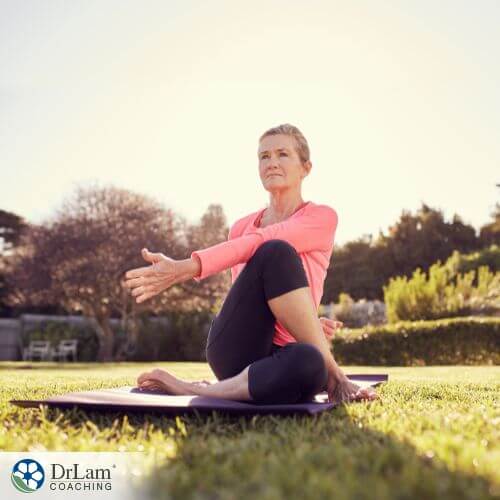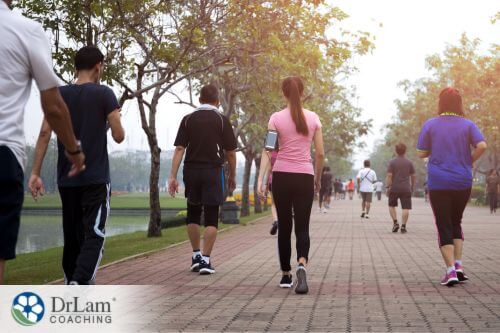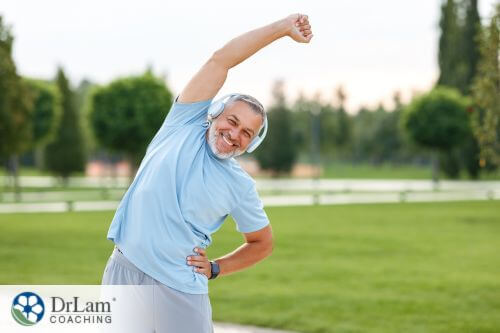 If you are faced with adrenal fatigue, you know that it’s a draining condition. This feeling may cause you to think that exercising is an impossible task. In fact, you might want to do any other activity besides exercising. Although adrenal fatigue can affect your daily routine, you can work on your fitness and exercise with adrenal fatigue. Specifically, you might have to modify your approach and select specific exercises that can help to ameliorate some of your symptoms. Let’s look in more detail at how it’s possible to exercise correctly with adrenal fatigue and boost your fitness and overall well-being.
If you are faced with adrenal fatigue, you know that it’s a draining condition. This feeling may cause you to think that exercising is an impossible task. In fact, you might want to do any other activity besides exercising. Although adrenal fatigue can affect your daily routine, you can work on your fitness and exercise with adrenal fatigue. Specifically, you might have to modify your approach and select specific exercises that can help to ameliorate some of your symptoms. Let’s look in more detail at how it’s possible to exercise correctly with adrenal fatigue and boost your fitness and overall well-being.
Simply put, it depends on the stage of adrenal fatigue that you are experiencing. In the early stages, you can exercise, but you must always evaluate how your body feels after you exercise. If you're feeling very tired, it could mean that you are depleting your nutrient stores even more.
People in stages 1 and 2 (early adrenal fatigue) of adrenal fatigue may only feel tired occasionally and have a tendency to recover from any low-energy state quickly.
However, if you are in Stages 3 or 4 (advanced/ later adrenal fatigue) you may experience a constant low-energy state and fatigue, which tend only to worsen over time. As such, it is essential that you rest, build up nutrient and energy stores, and then, only perform gentle core-building restorative exercises until your adrenal fatigue is further along in recovery. Physical activities like yoga, breathing, tai chi, and stretching are good to start with.
The important thing to keep in mind is that exercise is a physical stressor. As such, it can worsen hypothalamic-pituitary-adrenal axis (HPA) dysfunction if you overdo it. According to an article in Frontiers in Behavioral Neuroscience, the HPA functions to maintain physiological homeostasis and is the main stress response system. With adrenal fatigue, exposure to chronic stress or inflammation from exercise can worsen adrenal exhaustion. That’s why you have to be selective with your exercise and make the modifications that account for your current health status.
Adrenal fatigue can often occur due to chronic stimulation of the sympathetic nervous system (SNS), which is responsible for the fight or flight response. As such, many of the best exercises for adrenal fatigue work to reduce the activation of this system by activating the parasympathetic nervous system (PNS), responsible for the "rest and digest" response.
When it comes to the best kinds of exercise with adrenal fatigue - in type, duration, intensity, and timing - you have to consider what can restore the adrenal glands, what’s likely to prevent an adrenal crash, and what's less likely to leave you feeling deleted after completing a workout. As such, gentle, low-intensity restorative exercises are ideal for people with adrenal fatigue.
Do note that before you begin any exercise routine, it’s a good idea to speak to your healthcare provider, especially if you suffer from more advanced adrenal fatigue or other health conditions.
 Some people might not see walking as an effective form of working out. However, it’s perhaps one of the easiest exercises that you can consistently maintain. You require no equipment or fancy gear to walk. It doesn't involve difficult moves. Simply, get a pair of good walking sneakers and comfortable clothing, and if you desire, step to your favorite music playlist at the park, through the woods, or on the beach. If you struggle with adrenal fatigue that compromises your health, walking is gentle enough to not exacerbate the condition. Furthermore, walking can improve cardiovascular health, minimize stress, balance your hormones and metabolism, and also help you to reach and maintain a healthy weight.
Some people might not see walking as an effective form of working out. However, it’s perhaps one of the easiest exercises that you can consistently maintain. You require no equipment or fancy gear to walk. It doesn't involve difficult moves. Simply, get a pair of good walking sneakers and comfortable clothing, and if you desire, step to your favorite music playlist at the park, through the woods, or on the beach. If you struggle with adrenal fatigue that compromises your health, walking is gentle enough to not exacerbate the condition. Furthermore, walking can improve cardiovascular health, minimize stress, balance your hormones and metabolism, and also help you to reach and maintain a healthy weight.
Yoga can improve both your physical and mental health by boosting balance, flexibility, and strength, and reducing stress. It can allow you to exercise with adrenal fatigue and stay fit.
Dysfunction of the HPA impacts the body’s ability to handle stress. This affects not only the adrenal glands but the central and peripheral nervous systems as well. As such, restorative yoga poses can help restore nervous system health and balance, helping your body to turn off the stress response and repair.
The mind-body restoration yoga sequence of poses may be the most effective, designed to connect the mind and body. Yoga also increases blood flow to the adrenals, and it triggers the nervous system to switch to the PNS, allowing calmness and deep healing to occur. Furthermore, the gentlest yoga poses for adrenal recovery include Easy Pose (Sukhasana), Child’s Pose (Balasana ), and Corpse Pose (Savasana).
Dr. Lam's Adrenal Yoga Exercises have been created specifically for adrenal fatigue sufferers. It's gentle and works on the core slowly and steadily and makes sure to increase in intensity based on what the body can handle. Dr. Lam himself used these yoga exercises to recover from adrenal fatigue.
Deep breathing exercises can help with your adrenal fatigue recovery and you can include it in your exercise plan. Breathing is an automatic response that many people don’t think about, and as such, they practice unhealthy breathing that can cause issues in people with adrenal fatigue. Breathing involves the intercostal muscles, abdominal muscles, and the diaphragm, and it is regulated by the somatic and autonomic nervous systems.
Deep, slow breathing can impact your heart rate by slowing it down. According to an article in the Journal of Medical and Dental Science, deep breathing triggers a relaxation response, activates the PNS, decreases inflammation, and can boost your cardiovascular and immune systems. As such, deep breathing exercises with adrenal fatigue can help alleviate some symptoms such as heart palpitations, depression, anxiety, and the inability to handle stress. It does this by shutting off the fight-or-flight response in your body.
Regular tai chi, a traditional martial art from China, is ideal for people who would like to exercise with adrenal fatigue and need gentle exercise. This form of exercise can help your adrenal glands by reducing SNS stimulation. The SNS is commonly activated as a kind of compensatory mechanism as a result of a lack of energy and hormone production by the adrenal glands. As such, people with adrenal fatigue can experience symptoms such as anxiousness, feeling wired and tired, heart palpitations, or fluctuations in blood pressure. Calming the SNS and activating the PNS allows the body to relax and the adrenals to heal.
Furthermore, based on a clinical trial report in the Journal of Multidisciplinary Healthcare, tai chi contributes to the production of CD34+ cells, which is a cluster marker for blood cells involved in the self-renewal, differentiation, and proliferation of cells in your body. In this vein, tai chi may support adrenal healing by producing these stem cells for their maintenance and regeneration daily.
 An essential part of any exercise routine is stretching, and it also makes a great gentle exercise for adrenal fatigue. If you suffer from adrenal fatigue, on the days that you do not engage in exercising, perform a gentle stretching routine instead. Focus on low-impact stretches that can keep a range of motion in your joints and prevent your muscles from tightening or becoming sore.
An essential part of any exercise routine is stretching, and it also makes a great gentle exercise for adrenal fatigue. If you suffer from adrenal fatigue, on the days that you do not engage in exercising, perform a gentle stretching routine instead. Focus on low-impact stretches that can keep a range of motion in your joints and prevent your muscles from tightening or becoming sore.
Additionally, stretching can balance your hormones, strengthen your metabolism, boost your heart health, calm your SNS, decrease inflammation, and help with detoxification. Static stretches are better than dynamic stretches since they pose the least risk of injury and are best for people who should avoid intense exercises. Static stretching is slow and controlled, while dynamic stretching involves whole-body movements through a larger range of motions.
The bioenergetic circuit of the NEM stress response is comprised of three organ systems including the liver, pancreas, and thyroid. It carries out several metabolic functions including converting, fat, protein, and carbohydrates in your body to the energy that’s needed by the cells in your body to fight stress. Stress is characteristic of Adrenal Fatigue Syndrome (AFS), which is the non-Addison's form of adrenal dysfunction, where the body's stress response cannot keep up with life's chronic stressors. AFS disrupts the proper functioning of different systems in the body, including the bioenergetic circuit.
In stage 1, the effect of stress on the bioenergetic circuit is mild, and early signs of metabolic overload can be present but are often overlooked. In stage 2, metabolic dysregulation emerges and more pressure is put on the adrenals for additional cortisol output. Obesity may become more apparent. In the later stages, the Bioenergetics circuit and metabolism can become unable to sustain normal functions.
Exercise can be a big help in counteracting symptoms such as obesity and also minimize stress levels. However, it can also worsen adrenal fatigue if you overdo it, so you must practice mindfulness when exercising with adrenal fatigue. A few things that you should keep in the back of your mind:
When you are exercising for adrenal fatigue, any exercise that you do should be aimed at supporting your overall health without worsening your fatigue. What should you expect from exercise? You should expect:
 An improvement in metabolism that efficiently breaks down nutrients
An improvement in metabolism that efficiently breaks down nutrientsIt’s possible to exercise with adrenal fatigue, but you have to use caution and pay attention to your body. Your stage of adrenal fatigue factors into the level of exercise that you’ll be able to perform. You want to avoid creating worsening symptoms or adrenal crashes. The key is to not overdo exercise. Exercise in the right amount, at the right intensity, is great for your whole body and overall health. For adrenal fatigue, just be sure to focus on gentle exercises and start small, paying attention to your body as you go.
Please speak to your qualified healthcare provider before jumping into an exercise routine. You may need a full assessment of your health, which should help you to decide on the best exercises to proceed with. Your healthcare provider is also the right person to ask for recommended exercise strategies based on your current health status.
If you need help determining your stage of adrenal fatigue or what types of exercise would be suitable for you, the team at Dr. Lam Coaching can help. We offer a free, no-obligation phone consultation at +1 (626) 571-1234 where we will privately discuss your symptoms and various options. You can also send us a question through our Ask The Doctor system.
Sheng, Julietta A, et al. “The Hypothalamic-Pituitary-Adrenal Axis: Development, Programming Actions of Hormones, and Maternal-Fetal Interactions.” Frontiers in Behavioral Neuroscience, vol. 14 601939. 13 Jan. 2021, https://doi:10.3389/fnbeh.2020.601939 https://www.researchgate.net/publication/348454282_The_Hypothalamic-Pituitary-Adrenal_Axis_Development_Programming_Actions_of_Hormones_and_Maternal-Fetal_Interactions
Alaguveni, T. & Devaki P. R. “Effect of Deep Breathing Exercise on Heart Rate Variability of Different Age Groups.” Journal of Research in Medical and Dental Science, vol. 9 (4). 2021, p:267-275, https://www.jrmds.in/abstract/effect-of-deep-breathing-exercise-on-heart-rate-variability-of-different-age-groups-70226.html
Sharma K, Maity K, Goel S, Kanwar S, Anand A. "Common Yoga Protocol Increases Peripheral Blood CD34+ Cells: An Open-Label Single-Arm Exploratory Trial." Journal of Multidisciplinary Healthcare, 2023; 16:1721-1736, https://doi.org/10.2147/JMDH.S377869 https://pubmed.ncbi.nlm.nih.gov/37377666/
The right way to exercise with adrenal fatigue is dependent on your stage of adrenal fatigue and requires mindfulness. You must choose exercises that are gentle, yet effective, like walking, tai chi, stretching, yoga, and adrenal breathing. Furthermore, listen to your body, don't over do it, and aim for an energy boost instead of exhaustion.